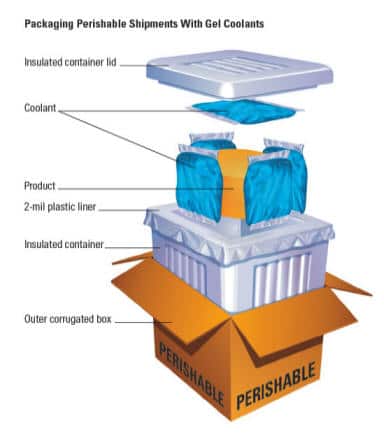
During shipping, insulation and refrigerants are key to preserving products like seafood, plants, meat, and fruits as well as dairy, medical, and chemical products. With the proper combination of insulation and refrigerants, you can maintain products within specific temperature ranges. You can keep products frozen, or prevent products from freezing. You can prevent melting and thawing in hot weather and minimize the effects of short-term temperature variations. We’ll show you how.
Insulation
We recommend insulation to reduce the transfer of heat through packaging container walls. The most common insulation materials are expanded polystyrene (EPS) foam, rigid polyurethane foam, and reflective materials (radiant barrier films).
Refrigerants
We recommend refrigerants such as gel coolants and dry ice to keep perishable products cold or frozen. However, do not uses dry ice as a refrigerant for live seafood such as lobsters; use gel coolants instead. Wet ice has many disadvantages, including weight and special water-resistant packaging requirements, but it may be used if properly prepared to prevent leakage.
General Guidelines for Packaging Perishables
• Package shipments to withstand handling in different orientations.
• Use a refrigerant that will keep products within the required temperature range. Use gel coolants for refrigerating products between 32ºF (0ºC) and 60ºF (16ºC). Use dry ice for frozen items.
• Use insulated foam containers with a minimum of 1-1/2"-thick walls.
• Bag perishable products that can melt or thaw, or shipments that contain liquid, using minimum 2-mil watertight plastic bags.
• Place foam containers inside sturdy outer containers.
• Include the address and 24-hour phone number of both the shipper and the recipient on each shipping label.
How to Keep Products Refrigerated During Transit
• Gel coolants are preferable to wet ice.
• Freeze the coolants according to the manufacturer’s guidelines.
• Precool the insulated container, if possible.
• If your shipment contains liquid or perishable products that could contain liquids, double-bag the products using minimum 2-mil watertight plastic bags and line the inside of the foam container with a minimum 2-mil plastic liner and absorbent material.
• Arrange products inside the insulated container, allowing space for coolants.
• Place a sufficient number of coolants on top of and around the product.
• Fill all void space with dunnage such as loose-fill peanuts to prevent product movement.
• Close the liner bag securely.
• Place the insulated container inside a corrugated outer box.
• Close and securely seal the corrugated box with pressure-sensitive plastic tape. Apply the tape overall box flaps and seams.
How to Keep Products Frozen During Transit
• Freeze products before packaging.
• Precool the insulated container, if possible.
• If the shipment contains liquid or perishable products that can melt or thaw, bag the products or line the insulated container using a minimum 2-mil watertight plastic bag.
• When arranging products inside the insulated container, allow enough space for dry ice.
• Place a sufficient amount of dry ice in the insulated container on top of and around the products.
• Fill void spaces with dunnage material such as loose-fill peanuts.
• Close the liner bag (if used) but do not completely seal it, as the carbon dioxide gas created by the dry ice must be allowed to vent.
• Place the lid on the insulated container.
• Place the insulated container inside an outer corrugated box.
• Close and securely tape the box with pressure-sensitive plastic tape. Apply tape to all flaps and seams. • Complete the required paperwork, dangerous goods labeling, and markings.







